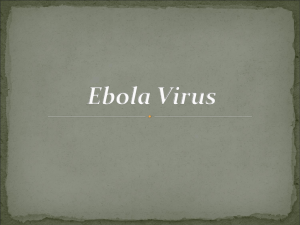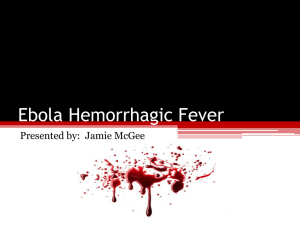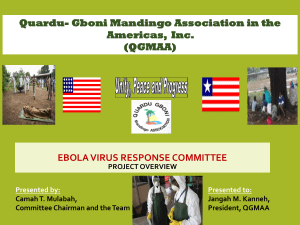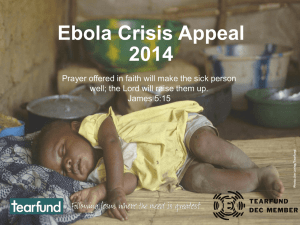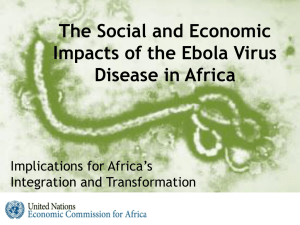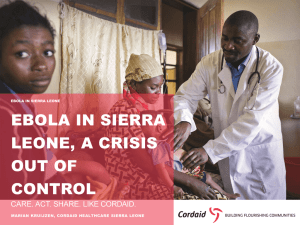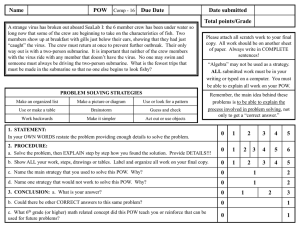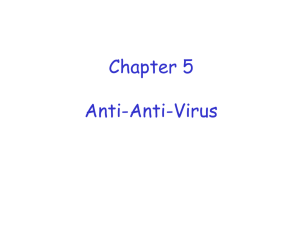The_Hot_Zone - WBR Teacher Moodle
advertisement
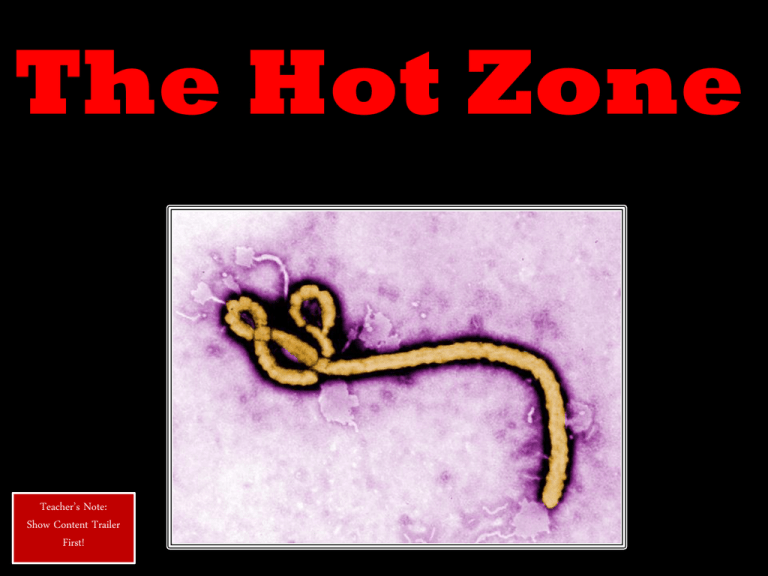
The Hot Zone Teacher’s Note: Show Content Trailer First! Charles Monet was a loner. He was a Frenchman who lived by himself in a little wooden bungalow on the private lands of the Nzoia Sugar Factory, a plantation in western Kenya that spread along the Nzoia River within sight of Mount Elgon, a huge, solitary, extinct volcano that rises to a height of fourteen thousand feet near the edge of the Rift Valley. 1. 2. 3. 4. Locate Kenya Locate the Nzoia River Locate Mount Elgon Locate the Rift Valley. Click on the image above to access The Hot Zone Google Earth KMZ file.. The headache begins, typically, on the seventh day after exposure to the agent. Monet felt a throbbing pain behind his eyeballs. He decided to stay home from work and went to bed in his bungalow. The headache grew worse. His eyeballs ached, and then his temples began to ache, the pain seeming to circle around inside his head. It would not go away with an aspirin, and then he got a severe backache. Exposure Day 7: Symptoms Begin Day 10 Monet becomes nauseated, spiked a fever, and began to vomit. At the same time, he became strangely passive. His face lost all appearance of life and set itself into an expressionless mask, with the eyeballs fixed, paralytic, and staring. The skin of his face turned yellowish, with brilliant starlike red speckles. He began to look like a zombie. Since he was very unwell and no longer able to drive a car, one of his co-workers drove him to a private hospital in the city of Kisumu, on the shore of Lake Victoria. 1. Locate Kisumu 2. Locate Lake Victoria. Thinking that he might have some kind of bacterial infection, they gave him injections of antibiotics, but the antibiotics had no effect on his illness. The doctors thought he should go to Nairobi Hospital, which is the best private hospital in East Africa. 1. Locate Nairobi. He could still walk, and he seemed able to travel by himself. He had money; he understood he had to get to Nairobi. They put him in a taxi to the airport, and boarded a Kenya Airways flight. A hot virus from the rain forest lives within a twenty-four-hour plane from every city on earth. All of the earth’s cities are connected by a web of airline routes.. The plane was a Fokker Friendship with propellers, a commuter aircraft that seats thirty-five people. Monet became airsick. The seats are narrow and jammed together on these commuter airplanes, and you notice everything that is happening inside the cabin. The cabin is tightly closed, and the air recirculates. If there are any smells in the air, you perceive them. You would not be able to ignore the man who was getting sick. He is holding an airsickness bag over his mouth. He coughs a deep cough and regurgitates something into the bag. The bag swells up. Perhaps he glances around, and then you see that his lips are smeared with something slippery and red, mixed with black specks, as if he has been chewing coffee grounds. His eyes are the color of rubies, and his face is an expressionless mass of bruises. The red spots, which a few days before had started out as starlike speckles, have expanded and merged into huge, spontaneous purple shadows: his whole head is turning black-and blue. The muscles of his face droop. The connective tissue in his face is dissolving, and his face appears to hang from the underlying bone, as if the face is detaching itself from the skull. The airsickness bag fills up to the brim with a substance known as the vomito negro, or the black vomit. The black vomit is not really black; it is a speckled liquid of two colors, black and red, a stew of tarry granules mixed with fresh red arterial blood. It is hemorrhage, and it smells like a slaughterhouse. The black vomit is loaded with virus. It is highly infective, lethally hot, a liquid that would scare the daylights out of a military biohazard specialist. His blood is clotting up – his bloodstream is throwing clots, and the clots are lodging everywhere. His liver, kidneys, lungs, hands, feet, and head are becoming jammed with blood clots. In effect, he is having a stroke through the whole body. Clots are accumulating in his intestinal muscles, cutting off the blood supply to his intestines. The plane lands at Jomo Kenyatta International Airport. Monet stirs himself. He is still able to walk. He stands up, dripping. He stumbles down the gangway onto the tarmac. His shirt is a red mess. Monet has been transformed into a human virus bomb. He walks slowly into the airport terminal and through the building and out to a curving road where taxis are always parked. The taxi drivers surround him – “Taxi?” “Taxi?” “Nairobi….Hospital,” he mumbles. 1. Locate Nairobi. A sign on the glass door says CASUALTY DEPT. Monet hands the driver some money and gets out of the taxi and opens the glass door and goes over to the reception window and indicates that he is very ill. He has difficulty speaking. The man is bleeding, and they will admit him in just a moment. He must wait until a doctor can be called, but the doctor will see him immediately, not to worry. He sits down in the waiting room. So Charles Monet is sitting on a bench in Casualty, and he does not look very much different from anyone else in the room, except for his bruised, expressionless face and his red eyes. A sign on the wall warns patients to watch out for purse thieves, and other sign says: PLEASE MAINTAIN SILENCE. YOUR COOPERATION WILL BE APPRECIATED. NOTE: THIS IS A CASULATY DEPARTMENT. EMERGENCY CASES WILL BE TAKEN IN PRIORITY. YOU MAY BE REQUIRED TO WAIT FOR SUCH CASES BEFORE RECEIVING ATTENTION. The human virus bomb explodes. Military biohazard specialists have ways of describing this occurrence. They say that the victim has “crashed and bled out.” Or more politely they say that the victim has “gone down.” He becomes dizzy and utterly weak, and his spine goes limp and nerveless and he loses all sense of balance. The room is turning around and around. He is going into shock. He leans over, head on his knees, and brings up an incredible quantity of blood from his stomach and spill it onto the floor with a gasping groan. He loses consciousness and pitches forward onto the floor. The only sound is a choking in his throat as he continues to vomit while unconscious. Then comes a sound like a bed sheet being torn in half, which is the sound of his bowels opening and venting blood from the anus. The blood is mixed with intestinal lining. He has sloughed his gut. The linings of his intestines have come off and are being expelled along with huge amounts of blood, Monet has crashed and bleed out. The other patients in the waiting room stand up and move away from the man on the floor, calling for a doctor. Pools of blood spread out around him, enlarging rapidly. Having destroyed its host, the agent is now coming out of every orifice, and is “trying” to find a new host. Click on the image to learn more! You will need your Discovery Streaming username and password! What is a Virus? Your Challenge! The U.S. Army Medical Research Institute of Infectious Diseases (USAMRIID) is investigating the death of Claude Monet. You have been hired to work on possible ways in which Monet contracted the Ebola virus. Before beginning your research, review the terms associated with the study of viruses as well as background information on Ebola. Use the Wordsmyth website, http://old.wordsmyth.net/home.php?content=glossary, to create a glossary of the following words. •Virus •Host •Antibodies •Contagious •Parasite •Replication •Epidemic •Immune system •Incubation period •Infection •Microorganism •Strain •Vaccine •Vaccination •Virulent Create and label the parts of a virus. Resource: http://www.ellenjmchenry.com/homeschool-freedownloads/lifesciences-games/virusmodels.php NOVA Video: Ebola: The Plaque Hunters, 1996 Watch Video from 1:15 to 6:25 Watch Video from 9:49 to 12:05 What is Ebola? How to you trace the spread of a virus? “Pass It On” 1. Prepare a classroom set of envelopes. Place a green paper strip in three envelopes and a white strip in the rest. 2. Distribute the envelopes. Explain that some people are carrying green or infected envelopes. Have students look inside their envelope. 3. Have the students circulate around the room for 60 seconds, until they hear STOP. They then whisper the color of their strip to the nearest person. Once a student hears the word green… they will whisper green at all consecutive STOP times. Complete a trial run until students understand the procedure. 4. Now follow the procedures TWO times. Once the second round is done, tell all students who received a green slip or who heard green at the first STOP but those who heard green at the second round to remain standing. 5. Repeat the procedure a third time. Tell students if they heard green at the second STOP, to sit down. 6. Distribute the handout and work as a class to fill out the Infection Tree. Resource: http://www.pbs.org/wgbh/nova/teachers/activities/2304_ebola.html Work as a class to complete an Infection Tree. NOVA Video: Ebola: The Plaque Hunters, 1996 Watch Video from 26:43 to 29:30 Watch Video from 31:44 to 37:26 How do you find the source of a virus? Now is your opportunity to be an epidemiologist. Use the information in Chapter 1 of The Hot Zone by Richard Preston and the Hot Zone Map that was completed previously Teacher’s Note: Provide copies of to determine possible causes of the Ebola virus. chapter 1. Present your findings to the scientist at U.S. Army Medical Research Institute of Infectious Diseases (USAMRID). Create a Prezi with your theory as to where Charles Monet may have become exposed to Ebola. Remember to back up your opinion with facts from Chapter 1! http://prezi.com/index/ Video 1: NOVA Video: Ebola: The Plaque Hunters, 1996 Watch Video from 12:30 to 15:21 Video 2: Click on the image above to view a video about containing a Level 4 virus. You will need your Discovery Streaming username and password! Are we at risk? Imagine if the Ebola virus or another Level 4 virus made it to the United States. View the video on the Monkey Pox scare from April 2012. Write a newspaper article as IF the virus HAD ESCAPED from the RESTON MONKEY HOUSE and caused a large scale emergency in Washington, D.C. Lesson Extensions 1. Find at least two articles on the Ebola virus. Summarize the articles and provide a copy of each article. 2. Choose a viral disease other than Ebola and make a pamphlet (trifold...standard size paper, filling all sides with information and diagrams/ pictures) that includes the following information in this order: Name of disease Name of specific virus Picture of virus Symptoms of the disease Methods of transmission Treatment of the disease Methods of prevention
